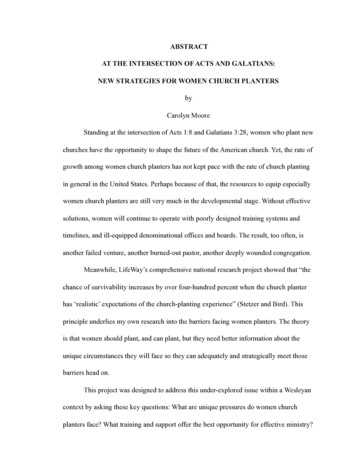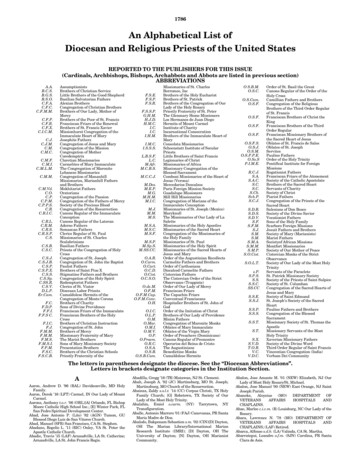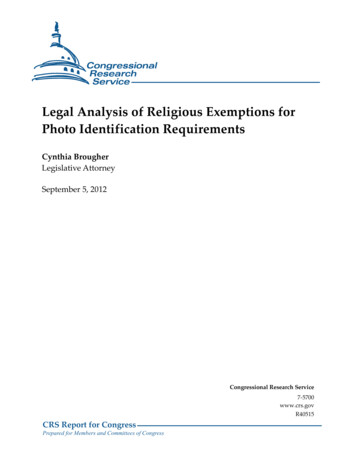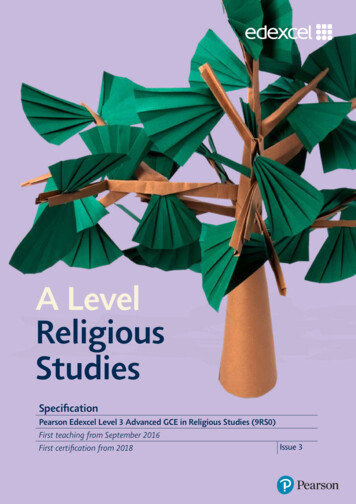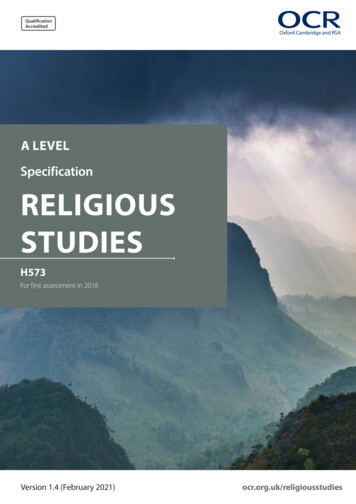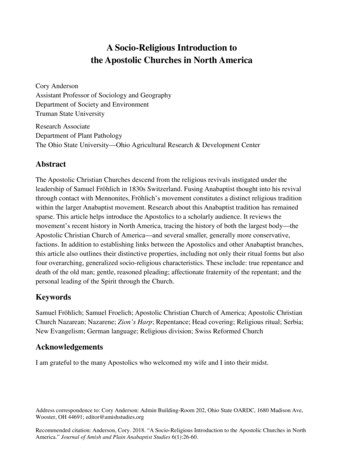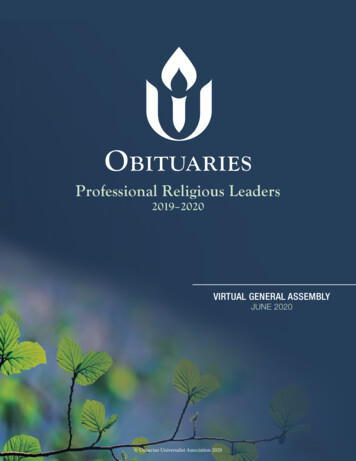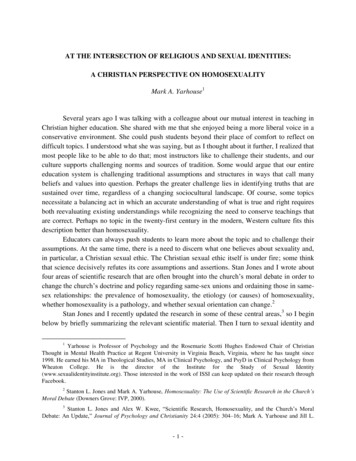
Transcription
AT THE INTERSECTION OF RELIGIOUS AND SEXUAL IDENTITIES:A CHRISTIAN PERSPECTIVE ON HOMOSEXUALITYMark A. Yarhouse1Several years ago I was talking with a colleague about our mutual interest in teaching inChristian higher education. She shared with me that she enjoyed being a more liberal voice in aconservative environment. She could push students beyond their place of comfort to reflect ondifficult topics. I understood what she was saying, but as I thought about it further, I realized thatmost people like to be able to do that; most instructors like to challenge their students, and ourculture supports challenging norms and sources of tradition. Some would argue that our entireeducation system is challenging traditional assumptions and structures in ways that call manybeliefs and values into question. Perhaps the greater challenge lies in identifying truths that aresustained over time, regardless of a changing sociocultural landscape. Of course, some topicsnecessitate a balancing act in which an accurate understanding of what is true and right requiresboth reevaluating existing understandings while recognizing the need to conserve teachings thatare correct. Perhaps no topic in the twenty-first century in the modern, Western culture fits thisdescription better than homosexuality.Educators can always push students to learn more about the topic and to challenge theirassumptions. At the same time, there is a need to discern what one believes about sexuality and,in particular, a Christian sexual ethic. The Christian sexual ethic itself is under fire; some thinkthat science decisively refutes its core assumptions and assertions. Stan Jones and I wrote aboutfour areas of scientific research that are often brought into the church‘s moral debate in order tochange the church‘s doctrine and policy regarding same-sex unions and ordaining those in samesex relationships: the prevalence of homosexuality, the etiology (or causes) of homosexuality,whether homosexuality is a pathology, and whether sexual orientation can change.2Stan Jones and I recently updated the research in some of these central areas,3 so I beginbelow by briefly summarizing the relevant scientific material. Then I turn to sexual identity and1Yarhouse is Professor of Psychology and the Rosemarie Scotti Hughes Endowed Chair of ChristianThought in Mental Health Practice at Regent University in Virginia Beach, Virginia, where he has taught since1998. He earned his MA in Theological Studies, MA in Clinical Psychology, and PsyD in Clinical Psychology fromWheaton College. He is the director of the Institute for the Study of Sexual Identity(www.sexualidentityinstitute.org). Those interested in the work of ISSI can keep updated on their research throughFacebook.2Stanton L. Jones and Mark A. Yarhouse, Homosexuality: The Use of Scientific Research in the Church’sMoral Debate (Downers Grove: IVP, 2000).3Stanton L. Jones and Alex W. Kwee, ―Scientific Research, Homosexuality, and the Church‘s MoralDebate: An Update,‖ Journal of Psychology and Christianity 24:4 (2005): 304–16; Mark A. Yarhouse and Jill L.-1-
recent research on identity development and synthesis as an often overlooked but potentiallyhelpful frame of reference for a Christian understanding of same-sex sexuality and behavior.1. Science, Homosexuality, and the Christian Sexual EthicChristianity affirms that God created people to be in relationships, in families (Genesis 1–2). Creation teaches and Jesus, Paul, and others in the New Testament affirm that God intendspeople to be born into families with heterosexual marriage. This is important because it is in thiscontext that God also places genital sex. Genital sex involves full sexual intimacy and itsbehavior expression. Christianity affirms that sexuality in general and genital sex in particularare good things, but it does not reduce human sexuality only to genital sex or behavioralexpression. Christianity teaches that lifelong heterosexual relationships are God‘s revealed willfor full genital sexual intimacy, for the specific expression of our sexuality through behavior.Christians understand sexuality to be a gift from God, an integral part of what it means tobe human. Genital sexual activity is the means of procreation, which not only brings about lifeand reflects the divine act of creation but also is the basis for family life in all culturesthroughout history. But sexuality is more than genital sexual activity. A Christian understandingof human sexuality is that it reflects who we are as much as or more so than what we do.5 Oursexuality instructs us of our need for God as we experience in our sexuality a longing forcompletion in another (eros). Indeed, a Christian understanding of sexuality focuses more onaffirming this longing for completion as something that exists regardless of marital status orsexual experience; it is fundamental to what it means to be human. We long for the other, forcompletion, and even marriage, the context in which genital sexual behavior is completed, onlypoints to the eternal or transcendent reality of completion in another. The marriage relationship,Scripture explains, reflects the relationship between God and ancient Israel6 and between Christand the church, the bride of Christ (Ephesians 5:22–33).4Kays, ―Homosexuality and Sexual Identity: An Update,‖ in Basic Issues in Sex Therapy (Doug Rosenau, MichaelSytsma, and Debra Taylor, eds.), classroom packet to be published by the Institute for Sexual Wholeness, Atlanta,GA.4See Mark A. Yarhouse and James N. Sells, Family Therapies: A Comprehensive Christian Appraisal(Downers Grove: IVP, 2008); Robert R. Roberts, Taking the Word to Heart: Self and Others in an Age of Therapies(Grand Rapids: Eerdmans, 1993), 81–105. It is in families that we learn much about ourselves, God, and others. Thefamily is where we are to learn about our dependence upon God and how to relate to one another, including a senseof mutuality (our responsibility and obligation to one another). Family also provides a setting in which we learn selfdenial and perseverance, as well as what it means to relate to one another with integrity. It is understandable, then,that God created the family as the context in which such important and far-reaching learning can take place.5An observation made by Lewis Smedes, Sex for Christians: The Limits and Liberties of Sexual Living(2nd ed.; Grand Rapids: Eerdmans, 1994), 231.6The Old Testament often compares Israel‘s idolatry to adultery against God. God reveals how importantidolatry is by drawing an analogy based on what humans know about marital intimacy (see Jeremiah 3:8). Cf.Raymond C. Ortlund, God’s Unfaithful Wife: A Biblical Theology of Spiritual Adultery (New Studies in BiblicalTheology 2; Downers Grove: IVP, 1996).-2-
Christianity, then, affirms that sex in marriage is a ―life-uniting act‖7 that is both physicaland tied to transcendent purposes. That is why Scripture compares the intimacy of Christ‘srelationship with the church to the marital relationship.8 This connection to transcendencecontrasts with what commonly occurs in our contemporary culture. Take, for example, the ―hookup‖ culture on many college campuses today.9 Christianity teaches that even hooking up is muchmore than just an exchange of bodily fluids, even if the two people engaged in the act insistotherwise. The act itself is tied to transcendent meaning that exists quite apart from the intentionsof the people involved. Sex has a spiritual dimension to it such that any sex outside of thecontext of a life-union of a man and woman violates the meaning and purpose of sex.How does homosexuality fit into this discussion? Perhaps this will come as a surprise, buthomosexuality is not the focal point of the Christian sexual ethic. Rather, same-sex behavior isone of many sexual acts that fall outside of the context of a life-union between a man and awoman, including pre-marital and extra-marital sex, pornography, and so on. Christianity beginswith a broader sexual ethic that affirms the good of physical creation and the good of ourinherent sexuality.10 Christianity then moves to an understanding that God locates people infamilies and identifies the union of a man and woman as the relationship in which completegenital sexual intimacy is to occur. Sex can occur outside of that context, of course, and such actswill continue to point to a purpose beyond itself, but they occur and exist outside of God‘srevealed will for genital sexual expression.The Catholic and Protestant or Reformed Christian traditions have reflected this biblicalunderstanding of life-long heterosexual marriage as the place or location for genital sexualbehavior. Although the Church has witnessed many attempts to change historical Christianteaching on sexual ethics, the Christian sexual ethic is grounded in Scripture, and Christians haveheld it throughout church history. Indeed, it would be a radical departure from church traditionfor Christians to bless or sanction same-sex behavior and relationships today. Those Christians7Smedes, Sex for Christians, 109, 112, 114–15, 181, 212. Smedes also discusses the instructional andpleasurable dimensions of sex. Sex has the potential to bring about new life and is the natural means by which acouple can procreate. Of course, not all sex in marriage brings about new life, whether by the intention of the coupleor as a result of infertility (which Christianity sees as a result of the fall). Nevertheless, sexual intercourse is themeans by which new life is formed, and the formation of new life occurs in a specific relationship: heterosexualmarriage.8Christine Colón and Bonnie Field note that while marriage is instructive of Christ‘s relationship to thechurch it should not be used to idolize marriage or denigrate being single. In fact, singles also reflect importantvalues regarding Christianity, including our primary loyalty and identity as followers of Christ rather than tied tobiological family. See Christine A. Colón and Bonnie E. Field, Singled Out: Why Celibacy Must Be Reinvented inToday’s Church (Grand Rapids: Brazos, 2009), 167.9Donna Freitas, Sex and the Soul: Juggling Sexuality, Spirituality, Romance, and Religion on American’sCollege Campuses (Oxford: Oxford University Press, 2008).10For a concise discussion, see Christopher Ash, Christianity and Sexuality (ed. D. A. Carson; Christ onCampus Initiative; Deerfield, IL: Carl F. H. Henry Center for Theological Understanding, 2009), 3-
who are making this shift seem to be doing so based on ―reason‖ and personal experience ratherthan the teachings of Scripture or church tradition.This brings us to our brief overview of the current understanding of reason and its usetoday in the church‘s moral debates. The four main areas are prevalence, causes, status as apathology, and change of sexual orientation. I will briefly review our understanding of these fourareas and their relevance to the church‘s moral debate.1.1. The Prevalence of HomosexualityAbout 2–3% of the U.S. adult population reports a homosexual orientation.11 Those whoargue that prevalence rates should affect how the church thinks about the moral debate oftenpoint to older studies, such as those conducted by Alfred Kinsey in the 1950s that suggestedhigher prevalence estimates.More recent research has confirmed these percentages as likely holding rather stable over12time, although it will be interesting to see if there is an increase in the self-report of attractionor orientation given a more open and permissive sociocultural context.13 In keeping with this lineof thought, homosexuality is more prevalent in urban settings than either suburban or rural ones.These differences are likely due both to people moving to urban settings to be with others whohave similar experiences and to a kind of dis-inhibition towards sexuality and sexual expressionthat can occur in urban settings. But taken together the national averages are about 2–3% of thepopulation.Would higher prevalence estimates affect Christian teaching in this area? Some argue thatit should, but Christianity has not historically considered how prevalent a concern is. Some mightargue that an increase in the rates of some behaviors might reflect greater or broader acceptanceof expressions of the fall that Christians should be not endorse. For example, sexual addiction isnow much more prevalent in the United States, yet Christians do not relate the prevalence ofsexual addiction to the morality of sexual addiction. Many Christians see it as reflecting a culturethat emphasizes individual interests and a hedonic worldview in which personal pleasure ispursued at the expense of others, particularly women, who are objectified in ways that further theinterests of others. The cultural dis-inhibition towards sexual expression that supports and11Edward O. Laumann, John H. Gagnon, R. T. Michael, and S. Michaels, The Social Organization ofSexuality (Chicago: University of Chicago Press, 1994).12P. J. Egan, M. S. Edelman, and K. Sherrill, Findings from the Hunter College Poll of Lesbians, Gays,and Bisexuals: New Discoveries about Identity, Political Attitudes, and Civic Engagement (New York: The CityUniversity of New York, 2008). Of the 2.9% who consider themselves gay, lesbian, or bisexual, 51.1% identified aslesbian, gay/homosexual, while 48.9% identified as bisexual. Males were more likely to be gay/homosexual (68.4%)than bisexual (31.6%), whereas females were more likely to be bisexual (65.3%) than lesbian (34.7%). Thesefindings are consistent with the understanding of greater sexual fluidity among females than males.13See Debby Herbenick, Michael Reece, Vanessa Schick, Stephanie A. Sanders, Brian Dodge, and J.Dennis Fortenberry, ―Sexual Behavior in the United States: Results from a National Probability Sample of Men andWomen Ages 14–94,‖ Journal of Sexual Medicine 7 (2010): 255–65. In this study, 4.2% of adult males identifiedthemselves as gay and 0.9% of adult females identified as lesbian.-4-
facilitates sexual addiction is not an improvement. So prevalence is not logically related to themoral argument. Christians recognize that some patterns of sin may be more common, such asenvy, while other patterns may be quite rare, such as necrophilia. How common or how rare apattern of behavior is has not historically determined its morality. Its prevalence and morality areseparate issues.1.2. Causes of HomosexualityThe debate about what causes homosexuality has also figured prominently in the churchmoral debates. Those who argue for changing the Christian sexual ethic claim if homosexualityis the result of biology then same-sex behavior is not outside of God‘s will for sexual expression.As I have met with families struggling with this question, they seem to be asking, ―Does Godmake people gay?‖ More accurately, the question is whether God makes a person attracted to thesame sex or whether God makes a person with a homosexual orientation. However, the reality ofsame-sex attraction or a homosexual orientation does not speak to whether it is from God or not.This points to the broader topic of a theology of sexual identity, including theodicy.14 It is aquestion of how to make sense of experiences that may result from the fall. Just as we do notinterpret the existence of predispositions toward depression or anxiety as God making a persondepressed or anxious, we want to be cautious about jumping to the conclusion that the existenceof an experience or condition reflects God‘s intention for that person. Even non-pathologicalconcerns, such as variations in normal human temperament or personality, can be understoodwith reference to God‘s intentions for persons. People may be predisposed to neuroticism (oremotional instability) but still have to think beyond ―God made me this way‖ to ―How does Godwant me to grow in Christ-likeness such that I display the fruit of the Spirit in my life and myrelationships?‖The biological hypothesis for the origins of homosexuality has been forcefully advancedfor two decades now. Studies have been published on a number of supposed connections,including research on twin studies,15 fraternal birth order and handedness,16 and animal models14Theodicy, which we discuss in greater detail in §5 below, refers to the theological study of God andGod‘s character in light of the existence of evil and suffering, including the impact of the fall on the created order,which can include natural disasters, gratuitous evil, the sin that is harbored in an individual person‘s heart, and soon. See D. A. Carson, How Long, O Lord? Reflections on Suffering and Evil (2nd ed.; Grand Rapids: Baker, 2006),15–35.15N. Långström, Q. Rahman, E. Carlström, and P. Lichtenstein, ―Genetic and Environmental Effects onSame-Sex Sexual Behavior: A Population Study of Twins in Sweden,‖ Archives of Sexual Behavior 39:1 (2008):75–80. Unfortunately, most human sexuality textbooks still cite the famous study by Michael Bailey and RichardPillard in which they reported a 52% probandwise concordance rate among identical twins. A far superior twin studyalso by Michael Bailey is the one in which he drew his sample from the Australian twin registry (a morerepresentative sample); the ―probandwise concordance‖ fell from 52% to 20% for identical twins. J. M. Bailey, M.P. Dunne, and N. G. Martin, ―Genetic and Environmental Influences on Sexual Orientation and Its Correlates in anAustralian Twin Wample,‖ Journal of Personality and Social Psychology 78 (2000): 524–36. The original, oftencited study with inflated probandwise concordance rates is J. Michael Bailey and Richard C. Pillard, ―A GeneticStudy of Male Sexual Orientation,‖ Archives of General Psychiatry 48 (1991): 1081–96.-5-
(in which homosexual behavior is either observed in nature or the result of genetic, hormonal orother manipulations).17 Some of the most recent research has considered genetic scanning18 andbrain symmetry and neural connections.19Someone interested in the research on the causes might ask whether any research is beingconducted on environmental contributions to homosexuality. As I mentioned earlier, thebiological hypothesis has been advanced for years now and remains the primary focal point.Studies of environmental contributions have not received funding, and previous studies havebeen neglected in favor of the current emphasis on nature over nurture.Given the limitations in the research that has attempted to establish biology as theprimary determinant in homosexuality, most experts today believe that sexual orientation is theresult of many possible contributing factors. These factors are likely weighted differently fordifferent people. The American Psychological Association may have it right when theorganization recently summarized the research:There is no consensus among scientists about the exact reasons that an individualdevelops a heterosexual, bisexual, gay, or lesbian orientation. Although much researchhas examined the possible genetic, hormonal, developmental, social, and culturalinfluences on sexual orientation, no findings emerged that permit scientists to concludethat sexual orientation is determined by any particular factor or factors. Many think thatnature and nurture both play complex roles; most people experience little or no sense ofchoice about their sexual orientation.20I think it is important that we recognize that people do not choose to experience same-sexattraction or to have a homosexual orientation as such. They find themselves with attractions16R. Blanchard, ―Review of Theory and Handedness, Birth Order, and Homosexuality in Men,‖ Laterality13 (2008): 51–70; R. Blanchard, J. M. Cantor, A. F. Bogaert, S. M. Breedloe, and L. Ellis, ―Interaction of FraternalBirth Order and Handedness in the Development of Male Homosexuality,‖ Hormones and Behavior 49 (2006): 405–14; R. Blanchard and R. A. Lippa, ―Birth Order, Sibling Sex Ratio, Handedness, and
Thought in Mental Health Practice at Regent University in Virginia Beach, Virginia, where he has taught since 1998. He earned his MA in Theological Studies, MA in Clinical Psychology, and PsyD in Clinical Psychology from Wheaton College. He is the director of the Institute for the Study of Sexual Identity
